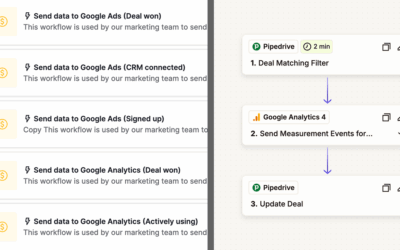Measuring b2b marketing shouldn’t be this hard.
With a lot of b2b marketing happening online, with all the tagging and tracking tools you’d expect that all you’d need to do to understand what’s working is to open a dashboard of one of your tools, and you’d have your answers.
Alas, this may be true if you go all-in in using a big platform such as Salesforce or HubSpot, and are happy to pay for one of their premium plans (thousands or tens of thousands per month).
But if you’re a small-to-medium-sized business using a mix of tools (say, Copper for CRM, Mailchimp for email marketing, and a website on Wix) you’ll have plenty of dashboards but none can tell you what works in marketing.
Marketing attribution, measuring the effectiveness of marketing channels and touches on closing sales is possible though, with a little bit of effort. We’ve done this at Outfunnel and we’ll happily share what the data says and how we did it.
The questions we were looking to answer (that any b2b marketer may want to have answered)
Some questions we wanted to have answered are broader, looking at the effectiveness of whole channels, others were more tactical in nature. Here’s what we looked at:
- Broadly, what channels are driving new leads in our marketing mix
- Following the money: how are each of the channels converting leads to paid
We then wanted to dig deeper into each of the main channels.
- Content marketing: what kind of content marketing is driving leads and conversions
- Social media: what drives traffic, leads, conversions
- Paid marketing: which ad platforms perform best
- A quick detour: what kinds of email addresses lead to conversions
And we then wanted to assess the effectiveness of individual marketing tactics. Namely:
- What’s the effect of a “consulting call” on conversion
- Do webinars help to convert signups to paid
- Does visiting our website during a trial help to convert leads to paid
What channels are driving new leads/trials for Outfunnel
Outfunnel can track website visits and it has access to some CRM data, so one of the first reports we ever built into the tool combined traffic source and won deals data.
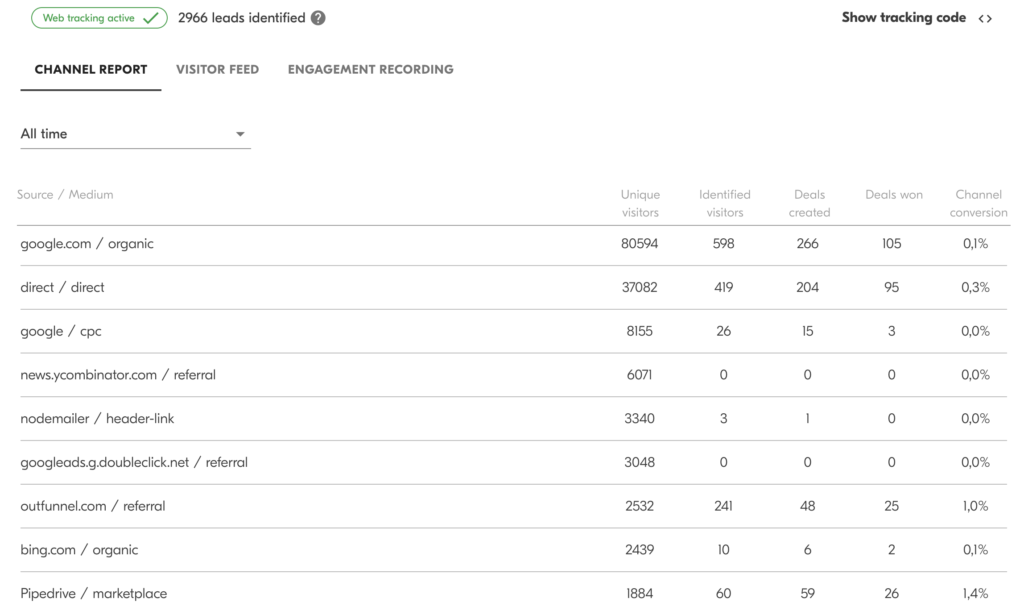
This data is somewhat useful, showing you which channels have been good at driving the most traffic, which ones have created trials, and which have led to paid conversions.
But where this data falls short is:
- Two major channels, Organic and Direct, have been defined using standard definitions, so the data can’t be used for meaningful analysis (more about this here)
- Because our free trial signups are created in our web app, not on our website, we’ve identified only approximately 2900 people out of more than 150,000 website visitors. And the share of identified people varies greatly by channel, so we don’t have enough data points for some channels.
To get around the latter problem, we’ve created a custom web tracking feature for our web app (loosely based on our standard web tracking feature). This way we can capture source and medium as well as landing page information for all trials.
So here you can see the clean, usable data about our key lead sources and conversion rates.
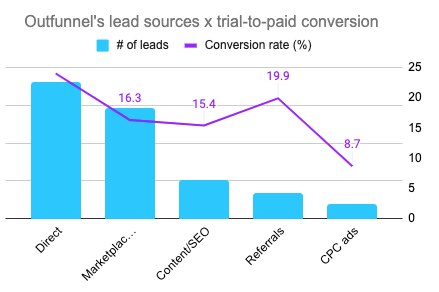
As you can see, our two biggest lead sources are Direct (people arriving on our website directly or via branded search or via “dark social”, definition as per this post) and Marketplaces – being present in places such as Pipedrive Marketplace, HubSpot Marketplace, and Calendly Integrations page.
Content/SEO is also an important channel with decent volume and a great amount more control over it compared to the first two.
Paid search is the channel that’s easiest to have control over, but due to budget constraints and conscious choices, it’s relatively small for Outfunnel.
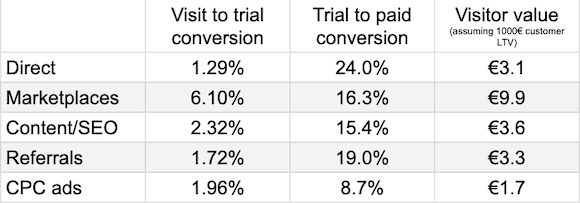
To get the full picture of how different traffic sources contribute to revenue, I’ve included web visitor to free trial conversion, as well as hypothetical customer lifetime value (LTV). In real life, LTV may vary greatly by channel and even within a channel, for example for different search keywords.
As you can see, visitors from the Marketplaces channel are the most valuable for us, and this channel has decent volume. Visitors from direct, content/SEO, and referral sources have a comparable value, with visitors from paid ads being relatively less valuable.
Doing this back-of-the-envelope type exercise shows us our target average cost-per-click for paid advertising as a nice side benefit.
Content marketing: what kind of content marketing is driving leads and conversions
We broadly do two kinds of content marketing (similarly to many businesses that sell b2b).
We write thorough blog posts that explain topics relevant to our audience, and that target a specific keyword. Most of the blog posts are informational in nature and people usually come across them when they are researching a subject, not necessarily buying something. Top-of-funnel, or ToFu in marketing lingo. For example, lead generation strategies or revenue marketing.
We also create landing pages that are targeted at people with a high intent to start using a tool or methodology. Bottom-of-funnel or BoFu, as marketers would say. For example Zapier alternatives or Mailchimp-Hubspot integration.
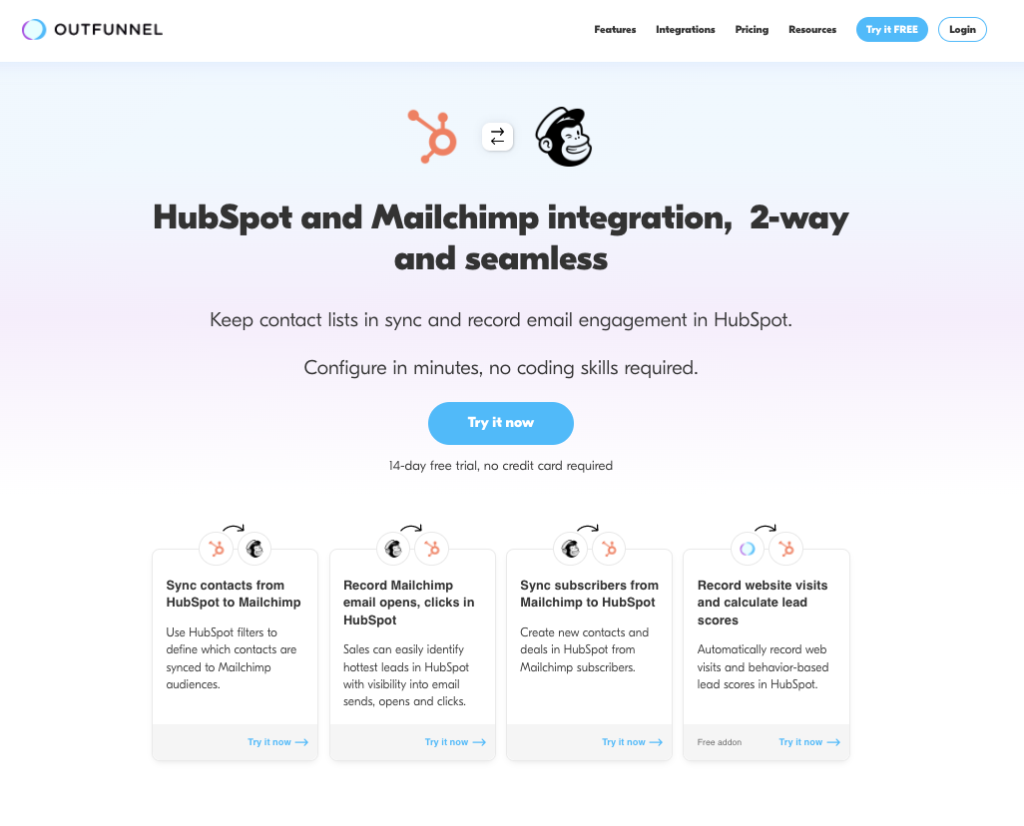
Thorough blog posts are usually harder to produce than landing pages, but they tend to get a lot more traffic. What’s more beneficial for Outfunnel currently? Here are the numbers:
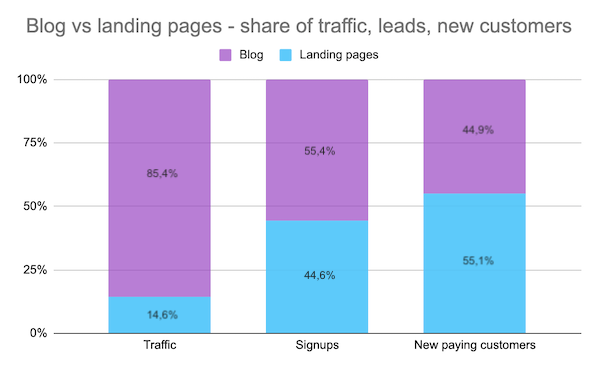
As you can see not all inbound organic search traffic is equal. Our blog is driving 85% of our organic search traffic but only 55% of our signups and 45% of our new paying customers from that channel.
The lesson? When you’re starting out, make sure you’ve done your keyword research and know which landing pages to build because these drive real short-term results. But don’t forget the more educational content that usually takes longer to have an impact but is a lot more scalable.
Social media: what drives traffic, leads, conversions
As mentioned before, traffic and leads from our partners are a core piece of our acquisition strategy. This comes in form of presence on marketplaces or integration listings, mentions on support docs, presence in community sites, and other relevant links here and there.
Another important referral channel for us is social media.

At first glance, YouTube seems to absolutely killing it in terms of conversion rates. But the volume is too small to draw any meaningful conclusions.
LinkedIn is the best social channel for driving traffic to our content but it has only generated one paying customer so far. And Twitter didn’t produce any free trial signups during the period in question.
Facebook is a bit more promising, but this very likely includes our own mentions of Outfunnel in some Groups related to using software that Outfunnel integrates with.
Last but not least: Quora. I spent some time answering Quora posts during the early days of Outfunnel but haven’t been active on the platform lately. My colleagues have also spent minimal time there but, looking at the table above, we would have been wise to do more. A very healthy 16,5% of visitors from Quora start a trial, and 18% of trials start a paid subscription.
This means that a visitor from Quora is worth an average of 30€ whereas visitors from other social media sites are worth 0-2.50€ (measured against the directly attributable impact on signups and paying customers and knowing that there would be other benefits such as the growth of awareness, cookied audiences, and newsletter lists).
The data above excludes any paid/CPC traffic from these sources, the topic of the next section.
Paid marketing: which ad platforms perform best
We also run ads. Google Ads is our most important advertising channel, but we’ve also used Capterra and experimented with other ad platforms such as Bing, Twitter, and Facebook.

Google Ads gives decent reach but we’re only able to convert 1,08% of traffic into free trials. Although conversion to paid is in double digits, our average visitor/click value is just 1.27€. Knowing Google’s click prices, this doesn’t leave a lot of room for profitability on average, but there are some ad groups and keywords that have a healthy CAC: LTV ratio.
Capterra’s traffic converts to trials notably better but alas conversion to paid is dismal, so the overall visitor value is similar to that of Google’s.
And as you can see from the table, our other CPC experiments haven’t included many winners.
Please note that I’ve left ROI calculations out from the above (don’t want to be oversharing) but with traffic source and landing page data added to each contact in our CRM, it’s very easy to calculate ROI for specific channels or keywords.
A quick detour: what kinds of email addresses lead to conversions
Before we get to the really juicy part and look at the effect of key sales and marketing “touches” on closed deals, let’s take a quick glance at something that’s very straightforward – what’s the difference in conversion between contacts that use a work email vs an email account provider like Gmail.
14,5% of Outfunnel’s trial accounts are created, using one of the email services like Gmail, Hotmail, or Yahoo Mail. And only 1,8% of them convert to a paid subscription, that’s nearly 10 less compared to accounts created, using a work email.
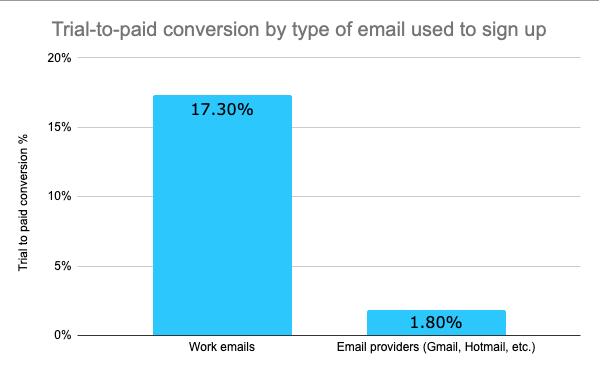
Should we stop allowing account creation with generic email providers? Numbers would suggest so. But anecdotally we’re seeing some users try out Outfunnel with their personal email, and later start a “proper” subscription with their work email, so we’re not in a hurry to change that.
Do webinars help to convert signups to paid
We started running weekly webinars about a year ago. We use Livestorm for webinars, because it works well, and because it integrates well with our CRM and logs registrations and attends as Activities there.
Attendance of webinars is not massive, less than 10% of people using a free trial register for one (at this stage we can’t offer time slots suitable for our global user base from Australia and Asia to Europe to US west coast). And of those that register, less than half watch it live but the correlation with conversion to paid is encouraging.
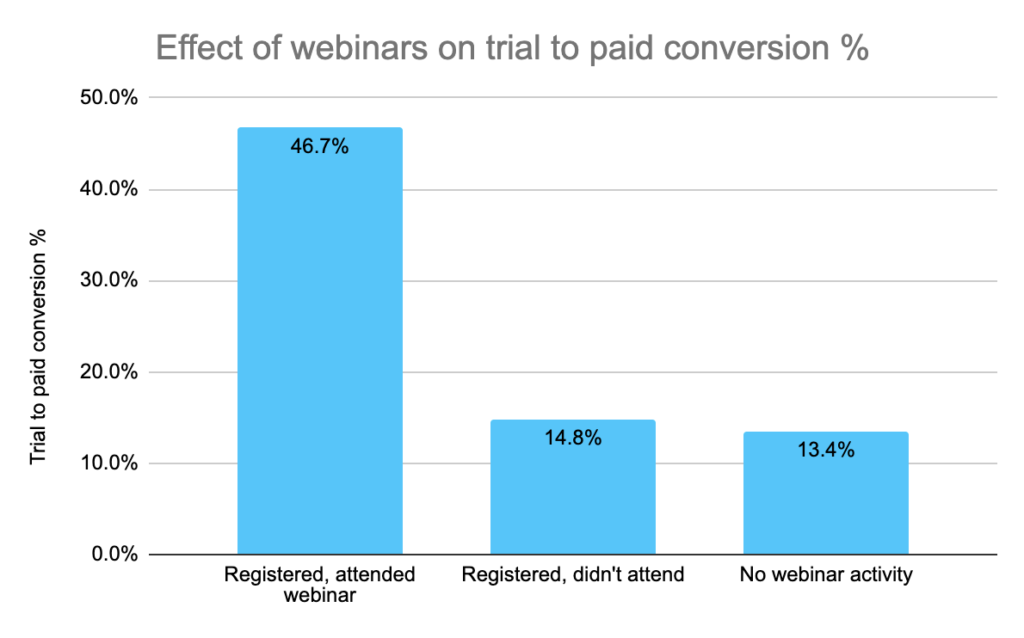
People that attend a webinar are 3 times more likely to start a paid subscription than those that don’t.
We can’t isolate causation from correlation here of course (people that convert to paid are more likely to engage with things like webinars) but the conversion rate increase is so notable we’ll definitely keep running webinars. Worst case scenario: we’ll have educated more people about our product.
What’s the effect of a “consultation call” on conversion
If webinars have a dramatic increase in helping to close deals, do 1-1 demos have a similar impact?
We’ve done demo calls since we started the company but we started properly logging demos into Pipedrive only in November of last year when we released our Calendly integration with Pipedrive (as well as Copper and HubSpot.) The integration neatly logs a custom activity to a Deal’s or Contact’s timeline, so you can analyze the correlation with winning sales later. Which is what we did, of course.
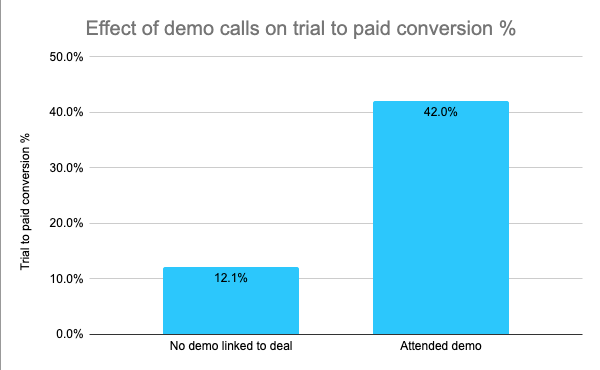
8,9% of trial users had a Calendly event linked to the deal/opportunity and, similarly to webinar attenders, these companies were more than 3 times more likely to start a paid subscription.
We’ll continue offering consultation calls during the trial, and will think of more ways to encourage scheduling one.
Does visiting our website during a trial help to convert leads to paid
Finally, we wanted to understand the effect of visiting the Outfunnel.com website during the trial.
First the caveat: our sampling may be off because we only could track the web visits of 3,3% of our free trial users. And this 3,3% are some of the most engaged users, having clicked on an email from us or filled a form on our website.
With that in mind here are the results:
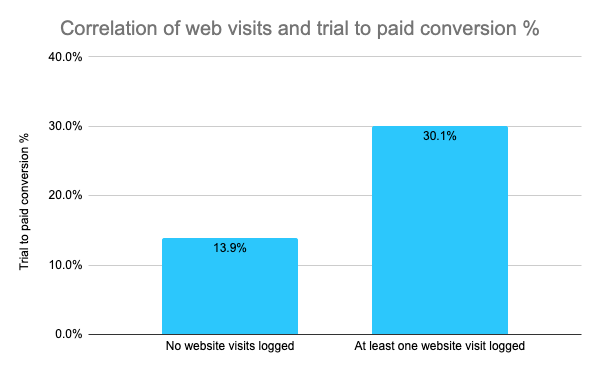
Visiting the website clearly correlates with conversion to paid. And, as with demos and webinars, we can’t claim causation here. But we can safely say that people who are more likely to convert engage with marketing and sales touches more, and people who engage with sales and marketing touches tend to end up buying in the end.
Combining sales and marketing data is a goldmine. Two things every company can do to access the nuggets
I hope you agree that combining sales and marketing data for proper marketing attribution is insightful. Here, one plus one really equals three or more.
- We can see which traffic sources lead to opportunities created, and to won deals.
- We can dive deeper into each of the channels and marketing tactics and evaluate the ROI of each.
- We know how various marketing and sales touches correlate with sales
The best part? Getting started is easy. And there are two things any company can do to start learning.
1. Record the lead source as a field or custom object in your CRM.
Companies with a small volume of leads can do this manually but you’re better off automating it. You can add a “How did you hear about us?” question in your lead form and/or use a tool that automatically captures traffic source data for each new contact and opportunity.
If you’re using Outfunnel, we’re already automatically capturing lead sources for you.
2. Log all marketing and sales touches in your CRM
In order to see correlations between various marketing and sales touches and driving sales, you’ll need to log all the activities in your CRM. Things like marketing email clicks, web visits, webinar registrations and attends, gated content downloads, everything.
One way to achieve this is to use software that integrates well with your CRM. (Which I guess is one of the drivers behind integrations being more important than features when buying software.)
Another way is to use third-party connectors like Zapier, Make, or Outfunnel, a tool purpose-built for connecting sales and marketing data.
You can then use built-in reporting in your CRM to do basic reporting, or export data and analyze it with heavier-duty tools as we did.
Want help with analyzing your sales and marketing data together?
We’re planning some Outfunnel features that would make compiling reports like the above effortless. If this is something you’d like to see with your data, we’d love to invite you to join our (affordably priced) beta/pilot program. Please get in touch for more details.
Appendix 1: our tools, tracking, definitions, channels
The tools we use at Outfunnel
- Pipedrive as our CRM
- our website runs on WordPress
- Contact Form 7 forms on the website
- Outfunnel and Mailchimp for email marketing
- Calendly for booking meetings
- Outfunnel to bring data from all these sources together, for example, to sync form fills from Contact Form 7 to Pipedrive
- Livestorm for webinars
- Google Analytics for general web analytics
- Outfunnel’s web tracking for capturing web visits of our users in our CRM
- A custom tracking tool that captures the source, medium, and UTM data along with the landing page for each new lead that signs up via our web app.
Appendix 2: the approach we took to combine sales and marketing data:
We’ve been treating our CRM as the “single source of truth” from day one. We’d been syncing most marketing engagements like web visits, form submissions, and email clicks into Pipedrive. (And by the way, this is super easy with Outfunnel.) But even so, Pipedrive lacked some information we had saved into our user database, and it also lacked advanced data analysis capabilities. Here’s what we did:
- We exported all Deals, Activities, and Organizations from Pipedrive
- We then exported information about all our free trials (leads) and paying customers from our custom database, including information about which source/medium/campaign they had originally come from
- We then asked Andres Kull, a data scientist and one of Outfunnel’s backers to combine these data sources in R.
And then we sat back and started learning what was working.



